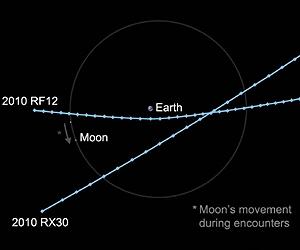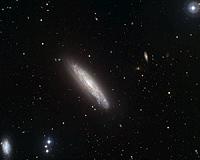|
 Two Asteroids To Pass By Earth Wednesday
Two Asteroids To Pass By Earth WednesdayPasadena CA (JPL) Sep 08, 2010 Two asteroids, several meters in diameter and in unrelated orbits, will pass within the moon's distance of Earth on Wednesday, Sept. 8. Both asteroids should be observable near closest approach to Earth with moderate-sized amateur telescopes. Neither of these objects has a chance of hitting Earth. A 10-meter-sized near-Earth asteroid from the undiscovered population of about 50 million would be expected to pass almost daily within a lunar distance, and one might strike Earth's atmosphere abo ... read more |
. |
|
|
Free Space, Earth, Energy And Military Newsletters - Delivered Daily |
| . | . |
| .. |
500,000 Solar Snapshots And Counting Greenbelt MD (SPX) Sep 03, 2010
Greenbelt MD (SPX) Sep 03, 2010On July 11th, amateur astronomers from around the world trekked to remote islands in the South Pacific to witness a total solar eclipse. They watched in awe as the Moon completely covered the Sun and revealed wispy, incandescent streamers in our star's million-degree atmosphere, the corona. These fleeting glimpses of the corona last just a few minutes and happen only every 19 months on ave ... more God did not create Universe: Hawking  London (AFP) Sept 2, 2010
London (AFP) Sept 2, 2010God no longer has any place in theories on the creation of the Universe due to a series of developments in physics, British scientist Stephen Hawking said in extracts published Thursday from a new book. In a hardening of the more accommodating position on religion that he took in his 1988 international best-seller "A Brief History of Time", Hawking said the Big Bang was merely the consequenc ... more Observations Of Supernova Reveal Composition Of 'Star Guts' Pouring Out  Boulder CO (SPX) Sep 03, 2010
Boulder CO (SPX) Sep 03, 2010Observations made with NASA's newly refurbished Hubble Space Telescope of a nearby supernova are allowing astronomers to measure the velocity and composition of "star guts" being ejected into space following the explosion, according to a new study led by the University of Colorado at Boulder. The team detected significant brightening of the emissions from Supernova 1987A, which were consis ... more |
.. |
 Extreme Effects: Seven Things You Didn't Know About Mercury  The Superwind Galaxy NGC 4666  Instant online solar energy quotes Solar Energy Solutions from ABC Solar |
.. |
|
|
Free Space, Earth, Energy And Military Newsletters - Delivered Daily |
|
|
. |
 Dawn Throttles Down
Dawn Throttles DownPasadena CA (JPL) Sep 03, 2010 Dawn's journey ever-deeper into the asteroid belt continues to go well, as the spacecraft carries out its familiar routine of thrusting gently with its ion propulsion system. But the interplanetary traveler has changed some of its habits, performing certain activities a little differently now from what its many followers have been accustomed to. Dawn is now so far from the sun, that even with its tremendous solar arrays, the most powerful ever used on an interplanetary mission, it does not receive ... read more |
| The contents herein, unless otherwise known to be public domain, are Copyright 1995-2010 - SpaceDaily. AFP and UPI Wire Stories are copyright Agence France-Presse and United Press International. ESA Portal Reports are copyright European Space Agency. All NASA sourced material is public domain. Additional copyrights may apply in whole or part to other bona fide parties. Advertising does not imply endorsement, agreement or approval of any opinions, statements or information provided by SpaceDaily on any web page published or hosted by SpaceDaily. Privacy statement |
| Previous Issues | Sep 07 | Sep 06 | Sep 03 | Sep 02 | Sep 01 |